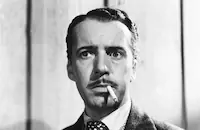"Who wants to go to hell with Madame Satan!"
Kay Johnson in Madame Satan
Producer-director Cecil B. DeMille must have felt he was in hell when he saw the box office receipts for Madame Satan (1930), an unpopular (at the time) hybrid of musical and romantic melodrama. Yet even though this strange tale of a straying husband who learns
the error of his ways when his wife dons a glamorous disguise and seduces
him just before a climactic dirigible crash seemed wildly uneven,
fans today appreciate the film for its ironic, Pre-Code humor and brazen attempt to
provide something for everyone.
DeMille had left the studio with which he would be associated most of his
life, Paramount, in 1929 in search of a better financial arrangement and
more control over his work. The result was a three-picture deal with MGM
that had started promisingly enough with the action hit Dynamite
(1929), his first all-talking film. To take advantage of the new medium,
studio head Louis B. Mayer urged him to tackle a musical, with Madame
Satan as the result.
The story was pure DeMille, harking back to such earlier hits as Old
Wives for New (1918) and Don't Change Your Husband (1919),
silent hits that combined risqu¿lots about the battle of the sexes with
moralistic endings that usually saw husband and wife reunited after at
least flirting with infidelity. Marital infidelity was nothing new to
DeMille. The writer of many of his films, including his silent sex
comedies and Madame Satan, was also his longtime mistress, Jeanie
Macpherson, who would remain on his payroll until her death in
1946.
DeMille kept things in the family by casting his adopted daughter,
Katherine DeMille, in her first recognizable screen role, as a society girl
attending the lavish party on the dirigible as one of Henry VIII's six
wives ( "a horrid fate for anyone's daughter" he would later call it).
Katherine's costume was made of silver and quite heavy. On her first day
of shooting, the six wives were required to dive into a circus net as part
of their escape from the dirigible. When the other girls resisted her
father's direction, Katherine had to take the leap first to shame the rest
of them into doing their jobs.
Other cast members had similar problems. Singer Lillian Roth, on loan from
Paramount to play the other woman, tried to get out of jumping from a ledge
200 feet above the stage floor (in full costume for the party--as a
pheasant). She begged her boss back at Paramount, Walter Wanger, to get
her a double, but ended up having to do the jump five times herself. Next
DeMille wanted her to jump through a sheet of candy glass (fake glass used
for stunts like that). On another film, she had seen comedian Lupino Lane
injured going through candy glass, so she protested. Just to show her how
safe it was, DeMille broke a sheet of it over his own head. She had no
choice but to comply.
Things were rough behind-the-scenes, too. MGM, still a relatively young
company at the time, didn't have enough sound stages to accommodate current
production, so each sound stage was used by three different film companies
in shifts. That meant that each day started with art director (and future
director) Mitchell Leisen supervising the reconstruction of the set, and
each day ended with his having it taken down again. In addition, the party
scenes were shot in an early form of Technicolor that required hot, intense
lights and limited Leisen's color palette. The strain resulted in a
nervous breakdown for Leisen, but shooting dragged on for so long that the film was
still in production when he'd recovered enough to return to work.
DeMille was too stubborn to ever have a breakdown himself, but he must have
come close to one when the box office results came in. The picture had
cost almost a million dollars to make and barely brought back half that
amount. In an effort to score on familiar territory, he suggested for his
next project a re-make of The Squaw Man, which had been his
first feature film in 1914. When that turned out to be an even bigger
disaster, he returned to Paramount, where he immediately bounced back into the
winners' circle with his Christians-vs.-lions epic The Sign of the
Cross (1932). He would never make another musical, though he would
maintain his working relationship with choreographer LeRoy Prinz through
the rest of his career. Ironically, Madame Satan had one important
effect on the future of the musical. Russian dancer Theodore Kosloff, a
star of several of DeMille's silent films and the lead dancer in Madame
Satan's "Ballet Mechanique" was a major influence on the work of
DeMille's niece, Agnes DeMille, whose choreography for Oklahoma! in
1943 would revolutionize the musical theater.
Producer-Director: Cecil B. DeMille
Screenplay: Jeanie Macpherson, Gladys Unger, Elsie Janis
Cinematography: Harold Rosson
Art Direction: Cedric Gibbons, Mitchell Leisen
Score: Herbert Stothart
Cast: Kay Johnson (Angela Brooks), Reginald Denny (Bob Brooks),
Lillian Roth (Trixie), Roland Young (Jimmy Wade), Elsa Peterson (Martha),
Boyd Irwin (Captain), Katherine DeMille (Extra), Theodore Kosloff
(Electricity, "Ballet Mechanique").
BW-116m.
by Frank Miller
Madame Satan

Brief Synopsis
A socialite masquerades as a notorious femme fatale to win back her straying husband.
Cast & Crew
Read More
Cecil B. Demille
Director
Kay Johnson
Reginald Denny
Lillian Roth
Roland Young
Dorothy Dehn
Film Details
Also Known As
Madam Satan
Genre
Musical
Comedy
Release Date
1930
Technical Specs
Duration
1h 55m
Synopsis
A socialite masquerades as a notorious femme fatale to win back her straying husband.
Director

Cecil B. Demille
Director
Cast

Kay Johnson

Reginald Denny

Lillian Roth

Roland Young
Dorothy Dehn
Betty Francisco
Marguerita Swope
Aileen Ransom
Lotus Thompson
Kasha Haroldi
Eddie Prinz
Natalie Storm
Louis Natheaux
Marie Valli
Jack King
Wallace Macdonald

Wilfred Lucas
Allan "rocky" Lane
Kosloff Dancers
June Nash
Elsa Peterson
Maine Geary
Vera Marsh
Countess Rina De Liguoro
Ynez Seabury
Elvira Lucianti
Vera Gordon
Katherine Irving
Earl Askam
Albert Conti
Miss Vernon
Jack Byron
Henry Stockbridge
Edwards Davis
Martha Sleeper
Lorimer Johnston

Ella Hall

Boyd Irwin
Julanne Johnston
Kenneth Gibson

Mary Carlisle
Doris Mcmahon
Tyler Brooke
Natalie Visart
Mary Mcallister
Youcca Troubetzkoy

Katherine Demille
Videos
Movie Clip




Film Details
Also Known As
Madam Satan
Genre
Musical
Comedy
Release Date
1930
Technical Specs
Duration
1h 55m
Articles
Madame Satan

Madame Satan
"Who wants to go to hell with Madame Satan!"
Kay Johnson in Madame Satan
Producer-director Cecil B. DeMille must have felt he was in hell when he saw the box office receipts for Madame Satan (1930), an unpopular (at the time) hybrid of musical and romantic melodrama. Yet even though this strange tale of a straying husband who learns
the error of his ways when his wife dons a glamorous disguise and seduces
him just before a climactic dirigible crash seemed wildly uneven,
fans today appreciate the film for its ironic, Pre-Code humor and brazen attempt to
provide something for everyone.
DeMille had left the studio with which he would be associated most of his
life, Paramount, in 1929 in search of a better financial arrangement and
more control over his work. The result was a three-picture deal with MGM
that had started promisingly enough with the action hit Dynamite
(1929), his first all-talking film. To take advantage of the new medium,
studio head Louis B. Mayer urged him to tackle a musical, with Madame
Satan as the result.
The story was pure DeMille, harking back to such earlier hits as Old
Wives for New (1918) and Don't Change Your Husband (1919),
silent hits that combined risqu¿lots about the battle of the sexes with
moralistic endings that usually saw husband and wife reunited after at
least flirting with infidelity. Marital infidelity was nothing new to
DeMille. The writer of many of his films, including his silent sex
comedies and Madame Satan, was also his longtime mistress, Jeanie
Macpherson, who would remain on his payroll until her death in
1946.
DeMille kept things in the family by casting his adopted daughter,
Katherine DeMille, in her first recognizable screen role, as a society girl
attending the lavish party on the dirigible as one of Henry VIII's six
wives ( "a horrid fate for anyone's daughter" he would later call it).
Katherine's costume was made of silver and quite heavy. On her first day
of shooting, the six wives were required to dive into a circus net as part
of their escape from the dirigible. When the other girls resisted her
father's direction, Katherine had to take the leap first to shame the rest
of them into doing their jobs.
Other cast members had similar problems. Singer Lillian Roth, on loan from
Paramount to play the other woman, tried to get out of jumping from a ledge
200 feet above the stage floor (in full costume for the party--as a
pheasant). She begged her boss back at Paramount, Walter Wanger, to get
her a double, but ended up having to do the jump five times herself. Next
DeMille wanted her to jump through a sheet of candy glass (fake glass used
for stunts like that). On another film, she had seen comedian Lupino Lane
injured going through candy glass, so she protested. Just to show her how
safe it was, DeMille broke a sheet of it over his own head. She had no
choice but to comply.
Things were rough behind-the-scenes, too. MGM, still a relatively young
company at the time, didn't have enough sound stages to accommodate current
production, so each sound stage was used by three different film companies
in shifts. That meant that each day started with art director (and future
director) Mitchell Leisen supervising the reconstruction of the set, and
each day ended with his having it taken down again. In addition, the party
scenes were shot in an early form of Technicolor that required hot, intense
lights and limited Leisen's color palette. The strain resulted in a
nervous breakdown for Leisen, but shooting dragged on for so long that the film was
still in production when he'd recovered enough to return to work.
DeMille was too stubborn to ever have a breakdown himself, but he must have
come close to one when the box office results came in. The picture had
cost almost a million dollars to make and barely brought back half that
amount. In an effort to score on familiar territory, he suggested for his
next project a re-make of The Squaw Man, which had been his
first feature film in 1914. When that turned out to be an even bigger
disaster, he returned to Paramount, where he immediately bounced back into the
winners' circle with his Christians-vs.-lions epic The Sign of the
Cross (1932). He would never make another musical, though he would
maintain his working relationship with choreographer LeRoy Prinz through
the rest of his career. Ironically, Madame Satan had one important
effect on the future of the musical. Russian dancer Theodore Kosloff, a
star of several of DeMille's silent films and the lead dancer in Madame
Satan's "Ballet Mechanique" was a major influence on the work of
DeMille's niece, Agnes DeMille, whose choreography for Oklahoma! in
1943 would revolutionize the musical theater.
Producer-Director: Cecil B. DeMille
Screenplay: Jeanie Macpherson, Gladys Unger, Elsie Janis
Cinematography: Harold Rosson
Art Direction: Cedric Gibbons, Mitchell Leisen
Score: Herbert Stothart
Cast: Kay Johnson (Angela Brooks), Reginald Denny (Bob Brooks),
Lillian Roth (Trixie), Roland Young (Jimmy Wade), Elsa Peterson (Martha),
Boyd Irwin (Captain), Katherine DeMille (Extra), Theodore Kosloff
(Electricity, "Ballet Mechanique").
BW-116m.
by Frank Miller













